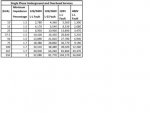ptonsparky
Tom
- Occupation
- EC - retired
Any one have an idea what the impedance is of a typical 25kva pole top POCO transformer? A range is fine. Any chance it will be less than 1.1%?
120/240v 1ph. It refers to the opposing polarity of the lines from the center tap as the point of reference.Educate me-
What is a "split phase transformer"?
Also, in case you were not aware, keep in mind L-N faults can be 50% higher than L-L faults on split phase transformers. I was alerted to this recently via PM when I was throwing out values based on just FLC /Vl-l. I have been meaning to start a thread on that as I don't fully understand it.
Educate me-
What is a "split phase transformer"?
Also, in case you were not aware, keep in mind L-N faults can be 50% higher than L-L faults on split phase transformers. I was alerted to this recently via PM when I was throwing out values based on just FLC /Vl-l. I have been meaning to start a thread on that as I don't fully understand it.

View attachment 23168
I suspect the L-G fault current is 2X because you are dealing with only half the split phase winding, and only half of the impedance, but still all of the primary fault current as the primary is one ungrounded conductor.
What is the source of this statement? Exactly what circuit is being referenced?Also, in case you were not aware, keep in mind L-N faults can be 50% higher than L-L faults on split phase transformers. I was alerted to this recently via PM when I was throwing out values based on just FLC /Vl-l. I have been meaning to start a thread on that as I don't fully understand it.
Gar190625-2333 EDT
electrofelon and ron:
I suggest you study electrical theory some, and do some experiments.
What is the source of this statement? Exactly what circuit is being referenced?
Do some thinking on the question, and do some simple circuit analysis.
You do not need a large transformer to experimentally study what happens. You do need to make clear definitions of the exact circuit to be tested, and what is to be tested.
Without really knowing what you are talking about I think the above quoted statement is grossly in error.
.
They show the impedance of the 120V winding as HIGHER than the 240v winding, but they use 210 amps (VA/120V) as the FLC. Cogitating on this....
190625-2333 EDT
What is the source of this statement? Exactly what circuit is being referenced?
.
I think the %Z is higher with the 120V winding than the 240V full winding because there is more leakage flux that does not couple to both the primary and secondary when using just the 120V half winding. That causes a higher leakage reactance which increases the transformer impedance. So although the fault current goes up with half the number of secondary turns, it does not go up by 2X because of the higher inpedance.
Also, in case you were not aware, keep in mind L-N faults can be 50% higher than L-L faults on split phase transformers. I was alerted to this recently via PM when I was throwing out values based on just FLC /Vl-l. I have been meaning to start a thread on that as I don't fully understand it.
you are only involving half the secondary winding, initial impedance is going to be about half the full winding impedance.
But that does not seem to be the case based on the figures from that PSE manual I posted. Unless you actual mean "impedance" and not "%Z". IT seems not completely clear how to state %Z with a center tapped transformer. What is "full load current" L-N? Seems like it should be 1/2 the KVA of the transformer.
